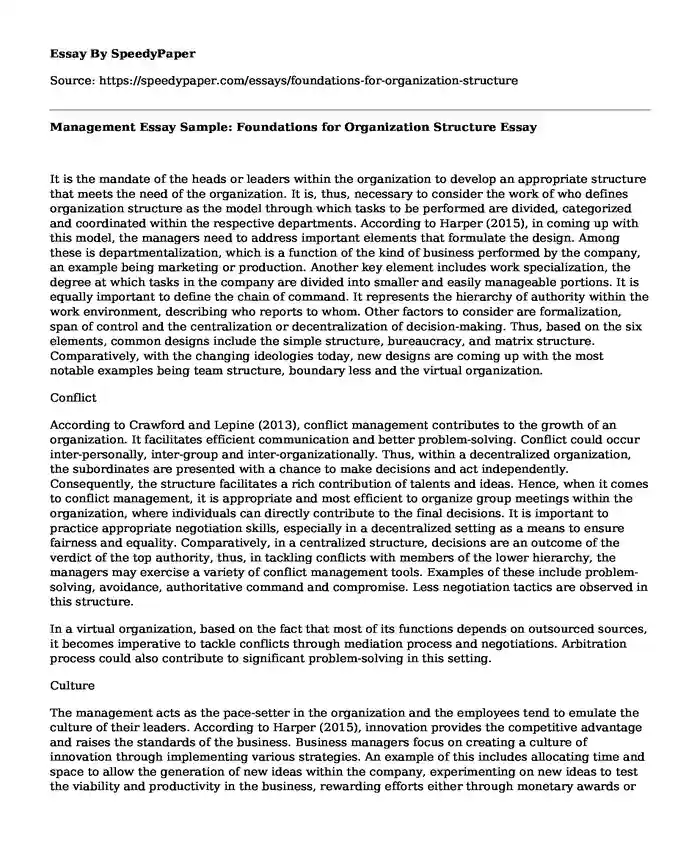
| Type of paper: | Essay |
| Categories: | Management Human resources Organizational behavior |
| Pages: | 3 |
| Wordcount: | 578 words |
It is the mandate of the heads or leaders within the organization to develop an appropriate structure that meets the need of the organization. It is, thus, necessary to consider the work of who defines organization structure as the model through which tasks to be performed are divided, categorized and coordinated within the respective departments. According to Harper (2015), in coming up with this model, the managers need to address important elements that formulate the design. Among these is departmentalization, which is a function of the kind of business performed by the company, an example being marketing or production. Another key element includes work specialization, the degree at which tasks in the company are divided into smaller and easily manageable portions. It is equally important to define the chain of command. It represents the hierarchy of authority within the work environment, describing who reports to whom. Other factors to consider are formalization, span of control and the centralization or decentralization of decision-making. Thus, based on the six elements, common designs include the simple structure, bureaucracy, and matrix structure. Comparatively, with the changing ideologies today, new designs are coming up with the most notable examples being team structure, boundary less and the virtual organization.
Conflict
According to Crawford and Lepine (2013), conflict management contributes to the growth of an organization. It facilitates efficient communication and better problem-solving. Conflict could occur inter-personally, inter-group and inter-organizationally. Thus, within a decentralized organization, the subordinates are presented with a chance to make decisions and act independently. Consequently, the structure facilitates a rich contribution of talents and ideas. Hence, when it comes to conflict management, it is appropriate and most efficient to organize group meetings within the organization, where individuals can directly contribute to the final decisions. It is important to practice appropriate negotiation skills, especially in a decentralized setting as a means to ensure fairness and equality. Comparatively, in a centralized structure, decisions are an outcome of the verdict of the top authority, thus, in tackling conflicts with members of the lower hierarchy, the managers may exercise a variety of conflict management tools. Examples of these include problem-solving, avoidance, authoritative command and compromise. Less negotiation tactics are observed in this structure.
In a virtual organization, based on the fact that most of its functions depends on outsourced sources, it becomes imperative to tackle conflicts through mediation process and negotiations. Arbitration process could also contribute to significant problem-solving in this setting.
Culture
The management acts as the pace-setter in the organization and the employees tend to emulate the culture of their leaders. According to Harper (2015), innovation provides the competitive advantage and raises the standards of the business. Business managers focus on creating a culture of innovation through implementing various strategies. An example of this includes allocating time and space to allow the generation of new ideas within the company, experimenting on new ideas to test the viability and productivity in the business, rewarding efforts either through monetary awards or recognition and the need to promote talent. It is important for the management to stay open to new ideas and become attentive in listening and considering the suggestions and proposals brought forth by their colleagues. Consequently, the management should appropriately manage these innovations and embrace failure, which could be an innovation in disguise.
Reference
Crawford, E. R., & Lepine, J. A. (2013). A configural theory of team processes: Accounting for the structure of taskwork and teamwork. Academy of Management Review, 38(1), 32-48.
Harper, C. (2015). Organization: Structures, processes and outcomes. Routledge
Cite this page
Management Essay Sample: Foundations for Organization Structure. (2019, Dec 11). Retrieved from https://speedypaper.com/essays/foundations-for-organization-structure
Request Removal
If you are the original author of this essay and no longer wish to have it published on the SpeedyPaper website, please click below to request its removal:
- Free Essay on Authority
- Historical Essay Sample on Abraham Lincoln and Civil War Impact on the US History
- Applying Assessment and Health Education Skills, Free Essay Sample
- Essay Example Dedicated to the "N" Word
- How the patient's portion is typically decided? Paper Example
- Paper Example. Managing Cultures
- Paper Example: Analysis of Legal Liability for the Conduct of Uber's Driver
Popular categories




